FRUIT TIPS
Buy fresh fruits that are in season ,they usually contain more nutrition at that time
Buy.
fruits that are dried as well as fresh, so you always have a supply on hand.
Keep fruits separate from meats and seafoods.
Vary your fruit choices as they differ in nutrient content.

ACKEE
ACKEE is a bright red tropical fruit that, when ripe, bursts open to reveal three large black seeds attached individually to a soft, creamy yellow flesh. It is edible, however the fruit must be allowed to ripen on the tree, otherwise it could be poisonous. In Jamaica, it is consumed with salt fish as the national dish.
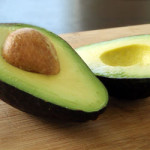
AVOCADO
AVOCADO is a pear-shaped tropical fruit with green, reddish-purple or blackish skin, and rich yellowish pulp enclosing a single large seed. The single seed is round in shape, hard and heavy. In Jamaica, avocados are usually eaten with lunch or dinner. The avocado was first cultivated in Jamaica in 1696 before making its way to the rest of the Caribbean.

BANANA
BANANA is a favorite food in most Caribbean islands and is also a major income earner. Ripe bananas are eaten raw while green bananas are boiled and eaten as a staple food.

BARBADINE
BARBADINE – the red flesh of the ripe fruit, with the inner skin removed, can be used as a vegetable or when cooked with sugar, eaten as a dessert, or be made into a jelly from the unpeeled flesh. The young, unripe fruit may be steamed or boiled and served as vegetable.

BREADFRUIT
BREADFRUIT – though it is a fruit, the light yellow flesh has the starchy consistency of unripe potatoes which makes it seem more like a vegetable. In the green stage, the fruit is hard and the interior is white and somewhat fibrous. When fully ripe, the fruit is relatively soft and the interior is cream coloured or yellow and pasty. The creamy white or light yellow flesh, when roasted, has the texture of freshly baked bread, giving the fruit its name. Breadfruit is usually seedless but there are also many varieties with seeds.

CARAMBOLA
CARAMBOLA is also popularly known throughout the Caribbean as Starfruit, Coolie Tamarind, Chinese Jimbelin and Five Fingers. On the tree, the fruit has a variety of appearances. The very ripe fruit has a golden yellow color, it has a lemon-green shade when it is half-ripe, and the unripe fruit is very green. They are all edible. The skin of the fruit is thin and somewhat waxy. and there’s no need to peel the fruit.
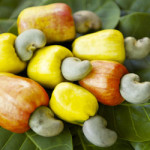
CASHEW APPLE
CASHEW APPLE is the oval or pear-shaped fruit of the cashew tree that develops from the receptacle of the cashew flower. When ripe, the fruit turns a bright reddish orange color. The fruit contains a nut which grows externally in its own kidney-shaped hard shell at the end of the fruit. The nut is edible when cooked or roasted, and is a popular snack.

CHERRY
CHERRY is a small, soft, round fleshy fruit that consists of a single hard stone seed. The cherries selected for consumption are derived primarily from two types, the sweet cherry and the sour cherry. Sweet cherries are very fragrant and juicy, while sour cherries are used mainly for cooking and in the making of confectionary items, jams and desserts. Cherries always have to be picked ripe as they do not ripe well after they have been picked.

COCONUT
COCONUT is a simple dry nut known as a fibrous drupe. It is a staple fruit in most Caribbean islands. Both the milk and meat are used extensively in cooking to prepare tasty dishes and pastries. Coconut water is also a very refreshing drink.
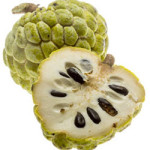
CUSTARD APPLE
CUSTARD APPLE – this fruit is heart-shaped with a thin skin that has a purplish-pinkish tinge when ripe. The pulp of the fruit is sweet and is either eaten plain or used in making fruit drinks.

GRAPEFRUIT
GRAPEFRUIT – the fruit has a slightly acidic and bitter taste and there are varieties such as the white, pink or ruby. The grapefruit is widely believed to have originated in Barbados.

GUAVA
GUAVA is the authentic Arawak name of this pungently scented fruit, which is eaten raw when ripe and is also used to make jelly or tinned nectar. It contains high amounts of calcium which is unusual in a fruit.
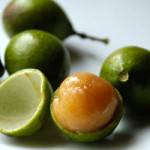
GUINEP
GUINEP – the fruit has a tight, thin, but rigid layer of skin, usually cracked by the teeth. Inside the skin is the tart, tangy, yellow pulp of the fruit, which is sucked by putting the whole fruit inside the mouth. The pulp can be juiced with lime and ginger to make a refreshing drink.
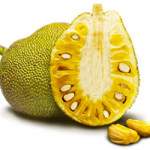
JACKFRUIT
JACKFRUIT is the largest tree borne fruit in the world. It is seldom less than 25 cm (10 inches) in diameter. The cylindrical shaped fruit has a rough kin which does little to mask the distinctively sweet odour of the pulp inside.
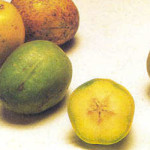
JUNE PLUM
JUNE PLUM – also known as golden apple and Jew plum, the fruit can be eaten ripe or green. June plum juice is made by blending the flesh with ginger and sweetening with sugar.
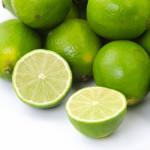
LIMES
LIMES, generally associated with lemons, are typically round, green to yellow in color, and contain a sour pulp. The fruit is used extensively in cooking and in the making of beverages.
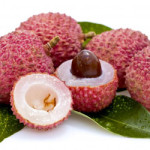
LYCHEE
LYCHEE, a native of southern China, the lychee was introduced to the West Indies in 1775. The fruit is covered by a leathery rind which is pink to strawberry-red in color and rough in texture. The edible portion of the fruit is white, translucent, firm and juicy. There is a distinction between the lychee that leaks juice when the skin is broken and the “dry and clean” varieties which are more desirable. Lychee can be used in the making of Jams.
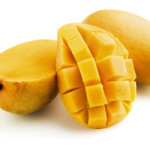
MANGO
MANGO, when mature, hangs from the tree on long stems. There are many varieties of mango, usually distinguishable by shape and the consistency of flesh. The ripe fruit is variably colored yellow, orange and red, reddest on the side facing the sun, and yellow where shaded. Green usually indicates that the fruit is not yet ripe. When ripe, the unpeeled fruit gives off a distinctive slightly sweet smell. In the center of the fruit is a single flat, oblong seed. The fruit is immensely popular in the Caribbean is also used to make juices.

NASEBERRY
NASEBERRY is native to Central America and the Caribbean. The fruit is round in shape and has a reddish brown skin. When ripe, the fleshy pulp may be eaten and can be used in making of desserts such as ice-cream.

ORANGES
ORANGES com in a wide variety and the flavours vary from sweet to sour. The fruit is usually peeled and eaten fresh, or squeezed for its juice. It has a thick, bitter rind that is usually discarded, but can be processed into animal feed by removing water using pressure and heat.

OTAHEITE APPLE
OTAHEITE APPLE – also known as Mountain Apple and Pommerac, the fruit is oblong-shaped and dark red in color, although some varieties have a pink and white skin. The flesh is white and surrounds a large seed, and makes a jam prepared by stewing with brown sugar and ginger.

PAPAYA
PAPAYA – the fruit is ripe when it feels soft and its skin has attained an amber to orange hue. The ripe fruit is usually eaten raw, without the skin or seeds, and may also be processed into juice, puree and jams. The unripe green fruit of the papaya can me eaten cooked, usually in curries, salads and stews.
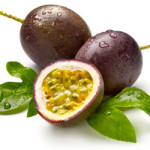
PASSION FRUIT
PASSION FRUIT know as parcha in Puerto Rico and chinola in the Dominican Republic, the passion fruit has a round to oval shape, is yellow or dark purple at maturity, and has a soft to firm, juicy interior filled with numerous seeds. There are two types of passion fruit and they have distinctly different exterior appearances. The bright yellow variety, also known as the golden passion fruit, has a smooth, glossy, light and airy rind, while the dark purple passion fruit is smaller than a lemon and has a dry, wrinkled rind. Passion fruit is eaten ripe and the juice is a popular beverage.

PINEAPPLE
PINEAPPLE – the name comes from the similarity of the fruit to a pine cone. This popular fruit is a native of Central and South America and was introduced to the West Indies by the Spanish. Eaten ripe, the fruit is also used as an ingredient or garnish in many cocktails.

PLUM
PLUM is a soft, round, smooth-skinned fruit that consists of sweet flesh and a flattish pointed stone. There are many different types of plums and they vary in season, size, color and taste. The fruit is sweet and juicy, and can be eaten fresh or used to make jam, jellies and other products. Plum juice can be fermented into plum wine and dried plums are known as prunes.
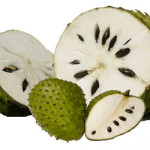
SOUR SOP
SOUR SOP – ovoid in shape, the soursop is covered with short, soft spines and is dark green in color, changin to a pale green when ripe. The fruit, though relatively difficult to eat as the white pulp is studded with many large seeds, is eaten when ripe and is sometimes used to make juices.

STAR APPLE
STAR APPLE is a native of the Greater Antilles (Cuba, Jamaica, Hispaniola and Puerto Rico) and was introduced from these islands to the rest of the tropical world. It has a round shape and is purple in color. However, sometimes there is a greenish-white variety of the fruit. The fruit is sweet and is perfect as a fresh dessert fruit. It is best served chilled.
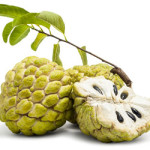
SWEET SOP
SWEET SOP – the fruit is usually round or oval and slightly pine cone-like with a scaly or lumpy skin. The creamy, sweet, custard-like pulp is edible and small black seeds are scattered throughout the flesh.

TAMARIND
TAMARIND – the fruit is a brown pod-like legume, which contains a soft acidic pulp and many hard-coated seeds. The pulp is edible and is mixed with sugar to make tamaring balls, a popular sweet, and can also be mixed with water and sweetened with honey or sugar to make a rich drink.

TANGERINE
TANGERINE is an orange or red colored citrus fruit. It is smaller than most oranges and due to its rough, pliable skin, does not require peeling and can be easily broken to reveal the large, juicy pegs inside. The taste is often more bitter than that of an orange.

WATERMELON
WATERMELON fruit, a relative of the cantaloupe, has a smooth green and yellow exterior rind, and a juicy, sweet, usually red or yellow interior flesh. The fruit is sometimes blended to make a refreshing drink.
